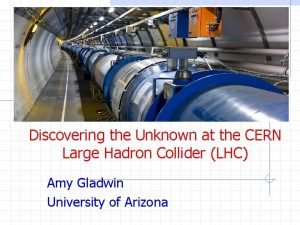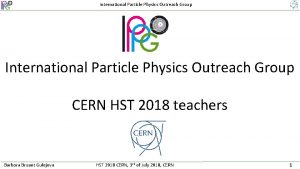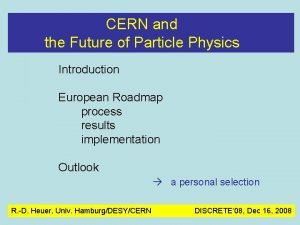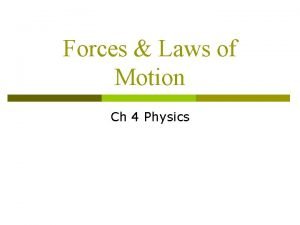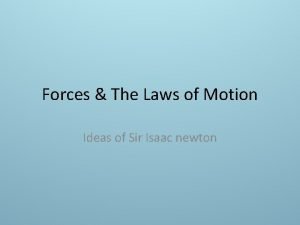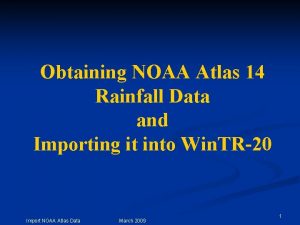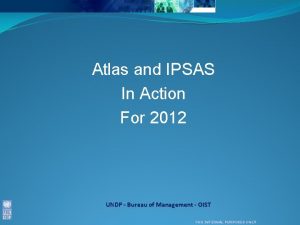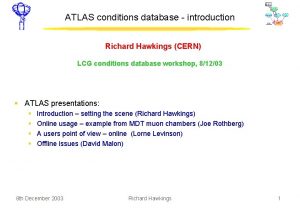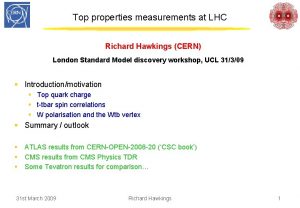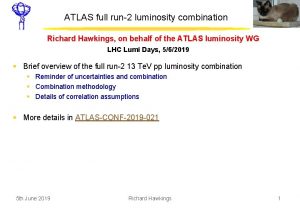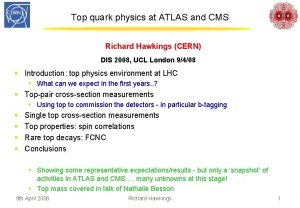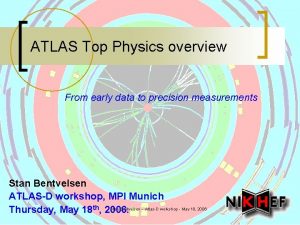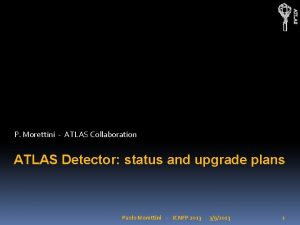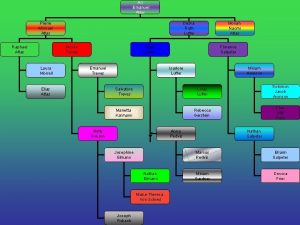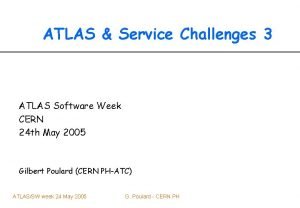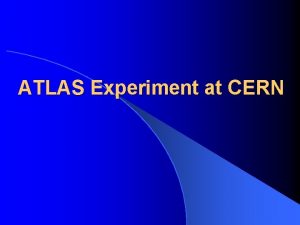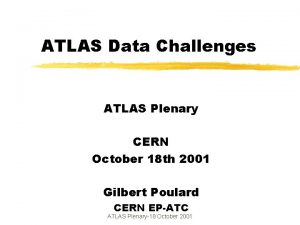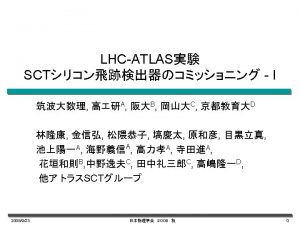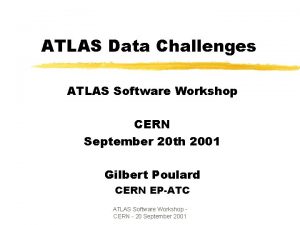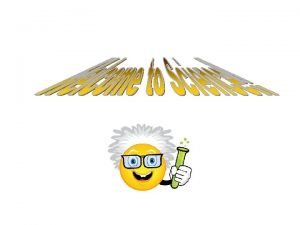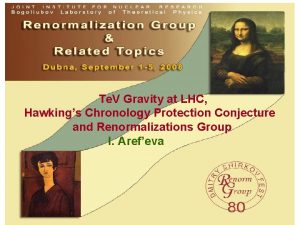Early top physics with ATLAS Richard Hawkings CERN






















- Slides: 22

Early top physics with ATLAS Richard Hawkings (CERN) LHC top physics workshop, Lisbon 13/3/09 § Introduction: top physics environment at LHC § What can we expect in the first years. . ? § Experimental ingredients for top physics at LHC § Electron and muon identification, jets, ET miss and b-tagging § Top-pair cross-section measurements § Initial ‘rediscovery’ and beyond § Single top cross-section measurements § Reconstruction of top pair events and the top mass § Conclusions § Concentrating on ‘early’ measurements and not on couplings and rate decays - covered later… § All results shown can be found in the ATLAS ‘CSC’ book CERN-OPEN-2008 -020 13 th March 2009 Richard Hawkings 1

Why top quark physics? § Top quark within Standard Model: § It exists! Measure its fundamental parameters (production cross-section, mass, charge, couplings, etc. ) § Electroweak corrections typically mt 2 – interesting for model builders § Heaviest known quark, least studied, some peculiar properties § Decays involve real rather than virtual W § Decays before hadronises – spin/polarisation information is preserved § Top quark beyond the Standard Model: § Top may be produced in new particle decays (t-tbar resonances, heavy H …) § Top quarks may decay in peculiar ways, e. g. t H+b § Top is a ‘template’ for many new physics topologies § Complex decay signatures involving leptons, missing energy, multi-jets, b-jets § Understand the detectors, develop the tools needed for hunting for exotic things § Top production will be a background to many new physics processes § H leptons, SUSY, more exotic things § Understanding top physics is essential in many searches 13 th March 2009 Richard Hawkings 2

Top quark production at LHC strong t-tbar pair production electroweak single top production (13%) (dominant) (87%) stt(th)=830± 100 pb @ 14 Te. V st(th) 320 pb @ 14 Te. V § At 1033 cm-2 s-1 (‘nominal’ low luminosity), get 1 top pair/second, or 8 M/year § 30% of these decay to {e/ } b jjb or {e/ } b final states, good trigger efi § At 1034 cm-2 s-1 (full LHC design luminosity before SLHC upgrade), get 10 Hz top pairs … O(100 M)/year § But background from pileup at 1034 will make precision studies difficult - analyses like top mass cocentrate on 1033 scenario 13 th March 2009 Richard Hawkings 3

Data samples in the first year of running § LHC will start with lower performance § Initial luminosity 1031 -1032 cm-2 s-1 § CM energy ≤ 10 Te. V in 2009 -10 § What can we expect…? Events in 50 pb-1 (ATLAS commissioning selection) § Current plan is to start in October 2009, run through to autumn 2010 § Then shutdown to complete consolidation and prepare 14 Te. V(? ) § Tt cross-section ~400 pb at 10 Te. V § Hope for O(100) pb-1 analysable data from 2009 -10 run § Very competitive with final Tevatron ttbar sample +good W mass, 100 pb-1 § Results here assume 14 Te. V! § ~factor 2 more L needed at 10 Te. V 13 th March 2009 Richard Hawkings 4

Accessing top physics at LHC § Typical analysis - semileptonic top decay § Hard (ET> ~20 Ge. V) isolated lepton § Electron and/or muon identification § Missing energy ET>~20 Ge. V § Both lepton and ET miss similar to W production § Hadronic W-decay: § 2 hard (ET>20 -40 Ge. V) light quark jets § Known mjj=mw – calibration of jet energy scale § 2 hard (ET>20 -40 Ge. V) b quark jets § b-tagging essential tool in top identification § Some opportunities for b-tag calibration t t § Explore/commission full range of detector capabilities (leptons, ET miss, jets, b-tagging) § Main background is W+multijet production § Multijet with fake lepton will also be important § Both difficult to simulate, need data normalisation § In dilepton channel, Z+jets and diboson prodn § Single top: similar ingredients, typically study semileptonic decay ({e/ } b ) 13 th March 2009 Richard Hawkings 5

Ingredients - electron identification § Leptons are key handle on top decays Electron candidates/100 pb-1 § Detector optimised for electron/muon ID § Huge background (~105) from jet production § Electrons identified by: § Shower shape in EM calorimeter § Matching high p. T track in tracking detector § Transition radiation in TRT (e/ separation) § Sources of electrons § Fakes from jets (especially at low ET) § Electrons from heavy flavour (b, c e) in jets § ‘Prompt’ electrons from W/Z (and top) § Top (and W/Z) physics requires isolation § Low activity in a cone around electron Rejection of non-isolated e in top events Endcap, 17 Ge. V Barrel, 30 Ge. V § E. g. ET<6 Ge. V in cone R<0. 2 § Effectively removes heavy flavour, leaving W, Z 13 th March 2009 Richard Hawkings 6

Ingredients - electron trigger and efficiency § Electron also used to trigger event p. T(e) in top decay § L 1 calorimeter trigger with fast sums § L 2 and EF based on full detector info § Good efi for 25 Ge. V threshold - around 85% of offline selected electrons Electron trigger efficiency (wrt offline) § Majority of t W e have p. T>20 Ge. V § Need to measure trigger and selection efficiency for electrons from data § Use copious Z ee decays to measure ‘generic’ efficiency with ‘tag and probe’ § Select one electron with standard cuts § Look for a second electron which makes Z mass, see how many pass ID cuts § Corrections needed to subtract fake b/g Probe e Z § Method can be used for trigger/offline § Corrections needed for Z top § Different isolation performance due to presence of extra jets § Eventually take from data, need statistics 13 th March 2009 1 -2% error for 100 pb-1 Tag e Richard Hawkings 7

Ingredients - muon identification and efficiency § Muons reconstructed in external muon spectrometer with toroid field § Matching to inner detector tracks reduces fake rate and improves p. T resolution § Fake rate for p. T>20 Ge. V ~10 -3 in top-pair events - K/ decays in flight and punch-through § Further improvements by cutting on match 2 § Efficiency ~90% but losses due to coverage § As for electrons, need isolation to remove muons from heavy flavour decays Muon trigger § Muon trigger: § Dedicated chambers (RPC, TGC) at L 1 § Full info at L 2/EF efficiency Efficiency p. T( )>10 Ge. V #fake muons/tt event § Measure efi using tagand-probe Z § As for electrons 13 th March 2009 Richard Hawkings 8

Ingredients - jet reconstruction and calibration § Quarks from t/W decay give jets in detector § Want to reconstruct energy and direction… § Fragmentation and hadronisation § Complex detector response to different particles; different technologies, dead material, cracks § Effects of clustering, jet algorithms, out of cone § Effect of ISR/FSR, underlying event and pileup § Jet efficiency (ET threshold), resolution, scale § § Just calculating acceptance (N jets > threshold) will take time and data /Z-jet balance to determine ET scale Particle types in jets photons K, p, n PT balance vs energy Z ee jet Z+1 jet event § Few % statistical precision with 100 pb-1 § Ultimate goal ~1% 13 th March 2009 Richard Hawkings 9

Ingredients - B-jet energy scale and missing ET § Complication for b-jets (important in top) b-jet energy scale, Jets with § 19% of b-jets contain a muon + neutrino § b , b c decays accompanied by § Effect does not occur in light jets - systematic underestimate of b-jet ET scale § If muon found in jet, can correct (O(10%)) § Similar effect also for electrons… § Stages of ET-miss calculation/refinement: § Calorimeter cells sum (noise suppression, calib) § Addition of identified muons (fake , ID/calo info) § Refine calo info for jets; estimate energy in dead regions tt {e, } bjjb § Genuine ET-miss in top events ( from W) § Remove b/g from QCD multijets with fake e/ ET-miss resolution evolution W {e, } Z § Missing ET measurement - sensitive to energy carried off by neutrinos in transverse plane 500 Ge. V dijets § Painstaking work to commission… § Can also use phsyics processes to help with calibration (including semileptonic top decays) 13 th March 2009 Richard Hawkings 10

Ingredients - b-tagging using top-pair events § Top-pair events offer source of b-jets for use in b-tagging efficiency calibration § Method I: Count number of events with 0, 1, 2, 3 b-tagged jets in cross-section seln b-vetos § Can determine b and c along with tt § Get b to ~5% (incl. syst) in 100 pb-1 § Method II: Exploit the topology / kinematics of the top-pair event to select the leptonic top b-jet, without using its b-tag info § Selection methods exploiting mass info, kinematic fit or jet/lepton kinematics § Jet samples ~70 -90% pure in b flavour, have to estimate and subtract background b-tag unbiased b-jet leptonic top mass § Can then study distributions of b-tagging input and output variables, calculate b § Get b to 5 -10% in 200 pb-1, can also look at distributions (e. g. b vs jet ET and ) § b determined in-situ, complementary to dijetbased methods also used at Tevatron 13 th March 2009 Richard Hawkings Abs stat error, 200 pb-1 11

Rediscovering the top quark § Detector performance will take data and time to understand § For initial top quark ‘rediscovery’… emphasis on simple selections § Select events with high ET lepton, missing ET and 4 jets (ET>20 -40 Ge. V) § Backgrounds from W+jets events, QCD multi-jet with fake lepton, single top § W+jet and multijet events can be reduced by requiring 1 or 2 b-tagged jets ( b~ 50 -70%) § But also interesting to look at simplified analyses without b-tagging: § Find combination of 3 jets which represents the hadronic top decay § Criteria such as largest sum p. T, good W mass between 2 of the jets Largest sum p. T, 100 pb-1 13 th March 2009 Richard Hawkings +good W mass, 100 pb-1 12

Top cross section in semileptonic channel § Extract signal using two methods: § Event counting (need background estimate) § Fit to 3 -jet hadronic top mass distribution +jets § Reduces sensitivity to W+jets background normalisation and jet energy scale § ISR/FSR (acceptance) modelling also important 100 pb-1 (e+ ) Stat (%) Syst (%) PDF (%) Lumi (%) Count 3 16 3 5 Likelihood 7 15 3 5 Statistical signficance vs L § Once b-tagging is available, use it: § With 100 pb-1, expect to commission b-tag and understand efficiency to ~5% § Helps with W+jets background reduction and combintorial background 13 th March 2009 e+jets § 5 sensitivity from ~ 20 pb-1 § Very clear signal at 100 pb-1, even with x 2 background Richard Hawkings 13

Top cross-section in dilepton channel § Di-lepton signal (l b l b) potentially very clean: § Background from Z ee, can be removed with mass cut, leaving Z , lepton+jets ttbar and diboson (WW/ZZ/WZ) Dilepton mass 100 pb-1 § e channel particularly clean (only Z is from ) § Require ET-miss + 2 jets… no need for b-tag § Cross-section extracted using counting, likelihood or template (ET-miss vs njet) 100 pb-1 Stat (%) Syst (%) PDF (%) Lumi (%) Count 4 5 2 5 Template 4 4 2 5 Likelihood 5 8 0. 2 5 Jet multiplicity § Systematics dominated by jet ET Stat+syst scale, ISR/FSR significance § Clear signal even with 10 -20 pb-1 § Probably the ‘discovery’ channel 13 th March 2009 Richard Hawkings 14

Properties of initial top-pair events § Once top-pair signal established, look at properties of events for non-SM behaviour Hadronic top p. T § Use semileptonic selection - study p. T and distribution of top… can also start to look for extra jets etc § Study top-antitop invariant mass distribution § Constrained fit to t-tbar system using known W and top masses (without b-tagging - could be used to reduce combinatorics) § t-tbar mass resolution 5 -9% from 200 -850 Ge. V t-tbar invariant mass 13 th March 2009 Richard Hawkings Hadronic top 15

Top cross-section using tau decays § Expect top-pair states involving same as e, b-tag weight of highest p. T jet § Branching ratio could be enhanced: t H+b § Important background for e. g. SUSY searches § Decay tt {e, } b had b (‘leptonic’) § Similar to semileptonic selection, but with identified hadronic tau replacing jets from W qq § Get additional rejection using 1 or 2 b-tagged jets § S/B 1: 10 without b-tagging, get 1: 1 with 1 b-tag § ~50 events, in 100 pb-1, b/g W+jets and single top § Can also use this channel to study -identification § Decay channel tt qqb had b (‘hadronic’) § No electron or muon - need to trigger on some combination of , N-jets and ET-miss § Require ≥ 4 jets, of which 2 must be b-tagged, plus identified hadronic § Expect about 300 candidates in 100 pb-1, with S/B~20 § Use to study identification and trigger (for events triggered on jets/ET-miss) § Both analyses are challenging - requiring well understood ID, jets, b-tagging, … § Will come later than the ‘discovery’ analyses with electrons and muons 13 th March 2009 Richard Hawkings 16

Single top production at LHC § Electroweak top quark production - contrast to pair production § Sensitive to new particles (e. g. H+, W’) and flavour changing neutral currents § Important background to many new physics searches (lepton, missing energy) § Overall cross section is large (c. f Tevatron), can distinguish contributions: s-channel: t=11 1 pb t-channel: t=247 12 pb Wt-channel: t=66 2 pb ( c. f. top-pair tt=830 50 pb ) § Large backgrounds from top pair production, also W+multijet and QCD jet events § At LHC - attempt to measure all production modes (s-chan & Wt challenging) § Can then extract |Vtb| and study polarisation, charge asymmetries, searches … § Basic event signatures: high ET lepton, missing ET, restricted number of (b) jets § Plenty of events, but large backgrounds which will have to be understood from data 13 th March 2009 Richard Hawkings 17

Single top production: t-channel cross-section § Require lepton, missing ET and one b-jet from the top quark decay b-jet p. T § Infer top quark mass using missing ET § Jet from light quark is forward, can require this jet and/or veto additional central jets § Second b-jet is usually soft - below ET cut § O(1 k) events per fb-1, similar size tt background large systematics (jet E scale, b, b/g) § Can be reduced by multivariate techniques - e. g. Boosted Decision Tree with event shape variables § Measurement to ~10% precision possible with 10 fb-1 § Then get |Vtb| to ~5% 13 th March 2009 BDT value ATLAS Mtop BDT>0. 6 Int. L Method Stat(%) Syst(%) Lumi (%) 1 fb-1 count 5 41 18 1 fb-1 BDT 6 19 9 10 fb-1 BDT 2 8 5 Richard Hawkings 18

Single top production: W-t and s-channel § Much smaller signal cross-sections, very large background § Especially from top-pair events where some particles are missed § W-t: channel: Single b-jet; look for two light jets consistent with W decay (l-j channel), or second lepton from leptonic W decay § Can use control region with similar kinematics but rich in top-pairs (e. g. require extra b-jet) to estimate background, cancel systematics W-t chan s chan § s-channel: Two b-jets, lepton + missing ET, no other high ET jets § In both cases, multivariate techniques can be used to enhance signal significance § Some representative analysis results - note small S/B and large systematics § Mainly from background - b-tagging/vetos, jet energy scales, PDFs, . . Channel Int. L Nsignal S/B Stat(%) Syst(%) Lumi (%) W-t (l+j) 1 fb-1 86 0. 38 21 43 20 W-t (l+j) 10 fb-1 860 0. 38 7 18 8 s-chan 10 fb-1 150 0. 19 20 44 18 § Need O(10) fb-1 of data and careful background studies to establish 5 signals 13 th March 2009 Richard Hawkings 19

Top reconstruction - for mass and more § Top mass, angular analysis need reconstruction of ttbar final state § 4 -vectors of all or some particles § Kinematic fits, exploiting constraints § E. g. W-mass in light jets from W qq should give known W mass Energy scale correction Reconstructed W-mass § Extra ‘in-situ’ calibration of light jet energy scale for the top-pair topology § Essential for top mass systematics § Analyses typically require ≥ 1 fb-1 § Make tight selections (4 jets ET>40 Ge. V) + b-tags § Various other cuts on reconstructed W and top § E. g. extract hadronic top mass from mjjb distribution Hadronic top mass § Statistical error 0. 3 Ge. V from 1 fb-1 data § Other techniques, e. g. global 2 fit also involving leptonic side of event, under development § Important for spin correlations, polorisation etc … 13 th March 2009 Richard Hawkings 20

Top mass measurement § Top mass quickly systematics dominated Uncertainty (1 fb-1) Value Light jet energy scale 0. 2 Ge. V / % b-jet energy scale 0. 7 Ge. V / % ISR/FSR ~0. 3 Ge. V b quark fragmentation ≤ 0. 1 Ge. V Background negligible Method 0. 1 -0. 2 Ge. V Light jet multiplicity § C. f. Tevatron current average 1. 2 Ge. V § Need to control light and especially b-jet JES to O(1%) to be competitive and exploit statistics (0. 3 Ge. V stat error in 1 fb-1) § This will take time and data… ISR/FSR changes Hadronic top mass, 1 -btag events § Control ISR/FSR from data distributions, e. g. jet multiplicity § For early data … can extract top mass with relaxed b-tag requirements § Start to learn about techniques and data 13 th March 2009 Richard Hawkings 21

Conclusions § LHC now has a firm ‘recovery’ schedule and expects to start in late 2009 § Hope for 100 -200 pb-1 data, mainly at 10 Te. V, by autumn 2010 § This gives a top pair data sample very comparable to that of the Tevatron § But we have to achieve a mature understanding of the detector. . . will take time § On the other hand, can make first observations with first ~20 pb-1 § Top analysis requires and exercises much of ATLAS object reconstruction § § § Electron and muon trigger and identification Jet reconstruction and energy scale Missing ET reconstruction Tagging of b-jets … all this will also help with understanding top as a background for searches § Initial measurements § Focus on top-pair cross section in dilepton, semileptonic and then other channels § Interesting measurements can already be done with 100 -200 pb-1 § Start to develop tools to go further - top reconstruction, single top backgrounds § Then move on to ‘new’ territory: single top, top properties, rare decays … 13 th March 2009 Richard Hawkings 22
 Athony hawkings merchant
Athony hawkings merchant Atlas cern
Atlas cern Looking for richard analysis
Looking for richard analysis Richard whiteley top gear
Richard whiteley top gear Early cpr and early defibrillation can: *
Early cpr and early defibrillation can: * Cern particle physics
Cern particle physics Cern particle physics
Cern particle physics Sum of forces equation
Sum of forces equation Forces and the laws of motion problem b
Forces and the laws of motion problem b Why does it happen
Why does it happen University physics with modern physics fifteenth edition
University physics with modern physics fifteenth edition Physics hl ia examples
Physics hl ia examples Objective of greek mythology
Objective of greek mythology Stt atlas nusantara
Stt atlas nusantara Silvaco tcad
Silvaco tcad Www.atlasti.com
Www.atlasti.com Noaa atlas 14
Noaa atlas 14 Who digital health atlas
Who digital health atlas Atlas.ti mac
Atlas.ti mac Atlas player tracker
Atlas player tracker Atlas copco xc2002 sensor fail s unack
Atlas copco xc2002 sensor fail s unack Atlas merupakan kumpulan
Atlas merupakan kumpulan Atlas undp
Atlas undp

